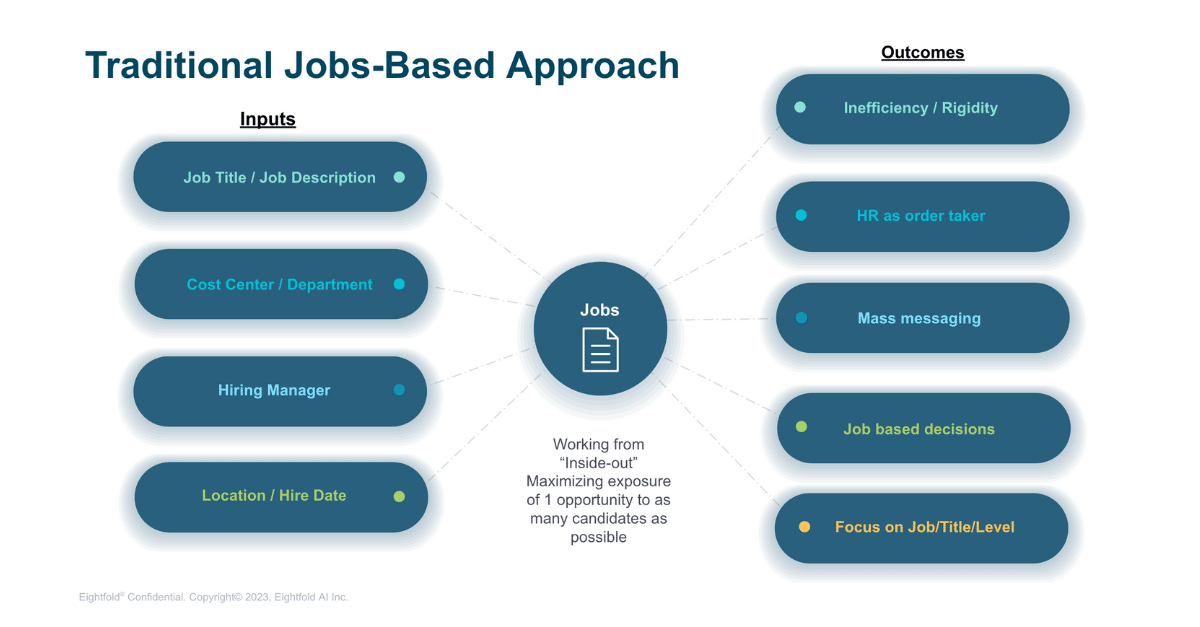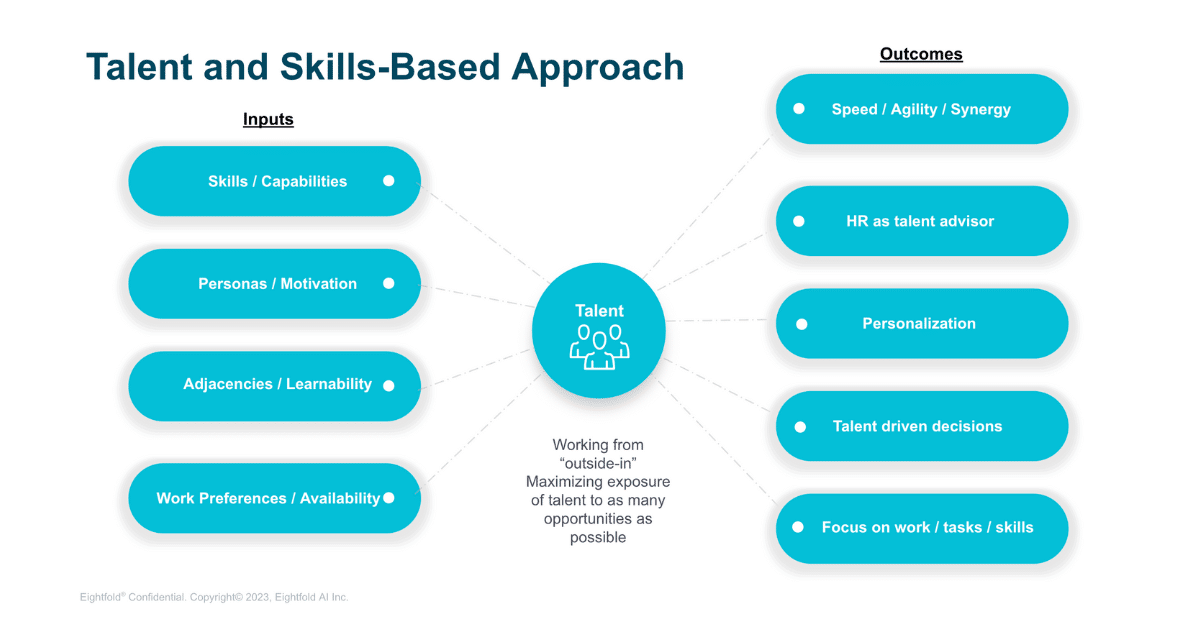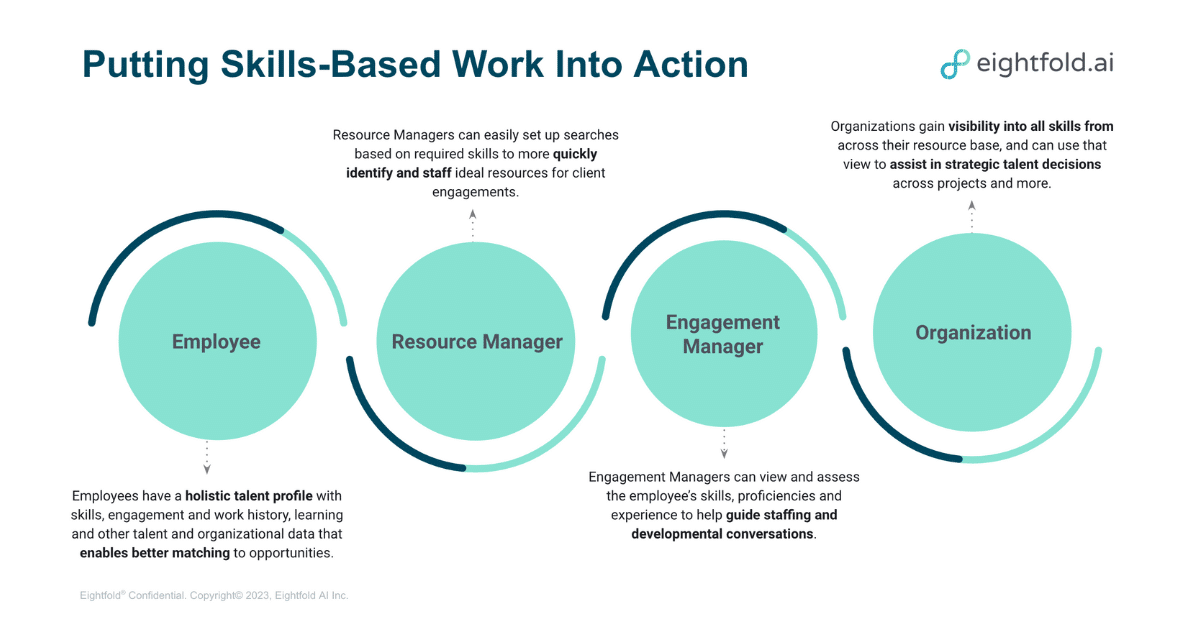We’ve long believed in the power of AI-powered talent intelligence when it comes to talent acquisition and management, but what if that same intelligence could be applied to project staffing?
Not only is this possible — it’s here. Eightfold Resource Management uses the power of talent intelligence to pair the right resources with the right project at the right time.
EY is one of our first customers to put Resource Management into practice. As an early adopter, Antony Shields, Partner and Global Digital Talent Leader at EY, talked to us about the firm’s journey with AI-powered intelligence informing project staffing. Shields discussed EY’s “NextWave Careers” initiative, and how EY is using Resource Management to create a better experience for employees.
We were excited to hear the key learnings, including EY’s shift to a talent-centric approach that focuses on skills instead of jobs so their leaders can better match people to projects. Here, Shields talked with Eightfold Director of Product Marketing Conor Volpe about their progress and key takeaways with Resource Management.
[Ed note: This conversation has been edited for length and clarity.]

Related content: Watch the full conversation from HR Tech with EY here.
Conor Volpe: We’re all programmed primarily to think about jobs and roles. That can lead to a very inside-out process where we take a specific job and try to bring it to as many possible people as we can. The job becomes the center of gravity for HR, but it doesn’t always serve HR to have that center of gravity be the job.
Antony Shields: Something that I’ve experienced in my career, 25-plus years in HR, is that effectively we have been setting up huge amounts of structure in HR, quite rigid processes, and there’s some good reasons for that. EY is a compliance-based organization, and we have to have that structure in place.
But at the same time, that structure has gotten to a point where we have turned into somewhat order-taking. … It has led to HR within EY and our clients to be too rigid, to be focused too much internally, and frankly, a lot of that work has been self-generating.

The modern approach to talent planning needs to move beyond being job-centric to …

To a talent-centered design around people and their skills.
CV: So instead of focusing on the job and all of its characteristics, instead we can look at a person’s skills or things like their persona, learnability, and preferences, and that leads to different outcomes that allow us to be more agile. It also allows HR to be more of an adviser rather than someone reacting to the needs of the business.
AS: That’s right. Most of our organization are [people] under 35 years old. So what are they looking for? They are not looking for jobs. They are absolutely looking for skills, and those skills are looking at being much more fungible.
CV: Given that EY is a consulting business, this is in theory how people get staffed on projects. It should be based on their skill set. So it makes sense you might be seeing this shift earlier.
AS: We are absolutely a pure-play people business. The only thing that professional services sells is trust and skills — those two things that enable us to deliver as you mentioned. Financial value, client value is the only way that we can do that.

Resource Management enables intelligent and efficient project-based work with four key tenets.
CV: So we’re starting to see this shift not only in your business, but in general, where the whole point is we have to be trusted. We have to bring the right value to the right client at the right time.
AS: I think it’s a brilliant one. That shift is going to be quite dramatic in terms of a change for HR, and that’s what we’re finding right now, and it’s very difficult. You would imagine that the opportunity to get involved in AI and skills would equal adoption, but that is not necessarily the case.
We’re having to work very hard to get that change in place because you’re working with those specific things that are so important for every one of us, which is: It’s my skill set, it’s my CV. But the opportunity for HR is to really make sure that they can shift into that wisdom area to truly become an enabler. And that is what’s happening in that skill shift right now.
CV: This makes a lot of sense for a business like yours where you mentioned this is the structure, but there are other businesses that need to make this shift as well.
AS: Every business has to get its people piece right. The reality is that this shift is so significant because we’ve never really been able to see our people. What I mean by that is we have looked at our people being a set of competencies capabilities, and yes, we focus too much on organizational structures. And as HR we became custodians of that as opposed to enablers.
The shift to looking at our people with the skills they have, identifying their skills profiles with AI, and enabling them to take control is such a significant shift — and not just for EY, but for any organization. … It’s actually the difference between making money or not, and often the difference between delivering on a client project or not.
CV: This shift from jobs to skills, from jobs to talent, this changes the way we think about our current jobs or how we think about career progression. It can be very linear. But if we focus on the talent and the skills that underlie that, it opens up all these various different paths.
AS: People don’t operate within a career structure that is entirely rigid. For us, that’s changed everything, and one of the things that’s challenging with this is through change management.
For EY people, this means that they suddenly have a whole lot of newness — the newness of AI. Suddenly, with our skills profiles, we’ve gotten them to be about 80% accurate within Eightfold, when our people come in, adopt, and say, “Yep, that’s my profile.” Initially, we were very challenged with getting people to do that. Even though you’d imagine that would be a good thing to update their résumés every six months. That’s not great if you’re trying to get hot skills out to the market.
When we first went live, we were only seeing adoption rates of 10-15%. And we were like, “Why is this? We’re offering something amazing here.” The reality was it was the newness. I think that’s what’s so important.
So this shift from jobs and to portfolios is a process that does require a significant amount of change, and you have to do things in a different way. We’re at about 90% [adoption] now so we’re happy, but that’s through a very different change process.
CV: Can you tell us a bit more about what Resource Management revealed, helping everyone see their skills and work more clearly, from employees to managers?
AS: We were absolutely amazed by the data that did not work, which was pretty much all the data that we’ve been using. The things that we picked up in the AI that were of incredible use and created that accuracy were things that I think you probably recognize if you step back from it. It’s how people have been learning because they had freedom to be able to choose this — their skills growth — through learning.
The reality is you and your brain have already made the decision before you go to it around the watercooler-slash-coffee machine — people resource the people that they know. So there is a significant shift into resourcing people they don’t know. And with the AI, this is surfacing real data around skills that should be used as opposed to what you think of being used.

Resource Management shifts the focus away from rigid talent pipelines to a portfolio strategy — talent moves where they’re most needed and can give and gain the greatest benefits.
CV: As you’re trying to move away from the rigid vertical structure of the pipeline toward that portfolio strategy, what does that unlock for EY?
AS: That’s unlocked a huge amount of potential. Once you’ve got visibility of skills, you can start to see how that can affect growth, in other words, learning.
So everyone talks about personalized learning, but until you actually have a snapshot of your existing skills and capabilities, and until you actually look at where your business is going and how those career paths map, I would argue that our big learning has been we can start to see how skills at the center of learning can actually generate proper personalized growth plans, as opposed to just pushing learning that may or may not be effective against someone’s job.
The integration of our learning platform into Eightfold has been key because we’re starting to see the uptake of learning and badges, and EY badges are very important, — it’s been a big success story for us. We’re starting to see the potential. We’re not there yet, but with that transparency of skills, you can start to see how you can really make that learning agile and powerful.

Resource Management benefits the entire talent ecosystem and organization by taking a holistic, skills-based approach to moving talent where they can offer the most value. Resource and engagement managers can also see the best-fit talent for any given project at any time, ultimately serving the organization’s goals.
CV: You mentioned NextWave Careers. This is a large initiative that you’re working on at EY to bring this together to address some of these issues.
AS: This is our current business strategy, NextWave. Effectively, this is how EY has been driving long-term value as a business.
What does long-term value mean? It’s really the shift from focusing primarily on financial and client value to looking at client value, financial value, people by value, and societal value. And this has really been at the absolute heart of our strategy.
NextWave Careers is absolutely at the heart of delivering that strategy, because this is not just about better career paths, but better learning and better visibility of skills for our people. That translates into better projects for our clients. And that translates into better financial value for us and for our clients.
CV: If we think about the lives of your consultants, providing an opportunity marketplace like that also provides transparency into where they could go in their career. It’s helping them take the next step.
AS: Absolutely. What we’re seeing is people playing with the system and having some fun, right? Putting New York on there and seeing how their profile fits against multiple roles. We’re seeing people in the UK looking for roles in India. They’re looking at how they can enhance their career through a move of that nature.
It’s quite exciting as you start to see the possibilities, but I would say this is not an easy journey. And the idea that “build it and they’ll come” doesn’t work. So effectively, we’ve been on a campaign of influence. We have global influencers now that I’ve done so much to get to the point where that marketplace is realizing its potential, but once the snowball begins, you really start to see it gathering pace.
To learn more about Resource Management, download our guide today.










